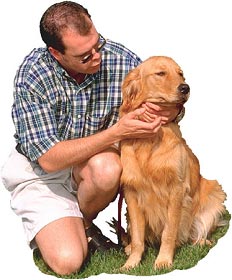Why
should I muzzle my dog?
If
you know your dog has aggressive
tendencies, then it is irresponsible
to risk the health of others
by not taking suitable precautions.
Muzzles can also be used to
test the dog's response
to potentially problematic situations,
to help introduce dogs that
might be aggressive to people
or other animals, and to temporarily
prevent damage to the household
in dogs that ingest or destroy
objects in the environment.
Aren't
muzzles cruel?
Muzzles
themselves are not cruel, but
they may cause welfare problems
if they are not used appropriately.
If the guidelines below are
followed, your pet will actually
enjoy being muzzled. The most
common errors are to only use
a muzzle when something nasty
is going to happen to your pet,
e.g. when he is about to be
injected; to expect your dog
to instantly accept the muzzle;
or to leave the muzzle on excessively.
What
types of muzzle are there?
There
are two common types of muzzle.
The basket muzzle and the nylon
muzzle. Both have their uses.
The basket muzzle allows your
dog more freedom to pant and
drink if properly fitted. The
nylon muzzle prevents the dog
from opening its mouth, but
may lead to overheating if left
attached too long since it restricts
panting and drinking. Some nylon
muzzles have a mesh over the
end to provide for a looser
fit and more opportunity to
pant, while others have a medium
size opening at the end for
the nose and mouth where small
tidbits can also be given. However,
the dog may still provide a
small nip with this latter type
of muzzle.
How
do I train my dog to enjoy being
muzzled?
- It
is important to find an effective
and comfortable muzzle for
your dog. This may take a
bit of time but it is worth
shopping around. Some muzzles
can be slipped off by pawing
so that a proper fitting muzzle
should be difficult if not
impossible for your dog to
remove. Some muzzles come
with (or can be affixed with)
a strap that attaches from
the muzzle over the top of
the dog's head (passing
between the eyes) to the dog's
collar so that it cannot be
pulled off by the dog.
- Your
dog should not be muzzled
initially in a conflict or
fearful situation. Show your
dog the muzzle, let him sniff
to investigate it and give
him a treat before putting
the muzzle away. Repeat this
procedure several times. This
starts to build a positive
association with the muzzle.
-
Next turn the muzzle to face
your dog and place some treats
inside, encouraging him to
take them out. Gradually place
the treats further inside
so that he sticks his head
all the way into the muzzle.
- Next
slip the muzzle on without
fastening it for a few seconds
and reward your dog when you
take it off. Slowly increase
the time you leave it on from
a few seconds to a minute
or more and no longer reward
your pet every time unless
he remains calm. Be sure to
set things up so your dog
succeeds, by only placing
the muzzle on for short periods
of time. We want the muzzle
to be removed when the dog
is calm and quiet, not fussing
or pawing.
- Now
that your dog accepts the
muzzle, you can try fastening
it. Again the length of time
that it is left on needs to
be increased gradually. While
the muzzle is on the dog your
dog can be rewarded with affection
or play if it can be sufficiently
distracted so that it does
not show any fear. If your
dog enjoys walks or games
of chase, this might be a
sufficient enough diversion
to help him or her adapt to
the muzzle more quickly. The
longer the time that the muzzle
is left on the greater the
reward should be when it comes
off, particularly if your
dog has made no effort to
remove it. You should aim
to work towards keeping your
dog muzzled for about thirty
minutes. The goal is to only
remove the muzzle when the
dog is calm and quiet, not
struggling. If you remove
the muzzle immediately after
the dog struggles or paws
at it, the dog may learn that
these actions get the muzzle
removed.
-
Start muzzling your dog before
you go for walks, but continue
to avoid situations that might
lead to fear, anxiety or conflict
for your dog. If you feel
you must take the muzzle off
for some of the time, do it
when you start to head home
and get your dog to keep to
a close heel on the lead as
long as the muzzle is removed.
Always give him lots of praise
when you take the muzzle off.
Once
this routine has been established,
your dog should be muzzled before
you encounter known conflict
or problem situations. Your
pet should still be muzzled
at other times for play and
walks so that it does not start
to resent or predict these few
necessary occasions.
You
should never remove the muzzle
when your pet is trying to remove
it. He can be encouraged to
leave it alone by a slight tug
on a lead. When he relaxes,
the muzzle can be removed and
take note that you may have
been expecting too much too
soon. The important rule is
to work at a rate that your
pet can accept and cope with.
This may mean that the whole
program may take a few weeks
rather than a few days. |